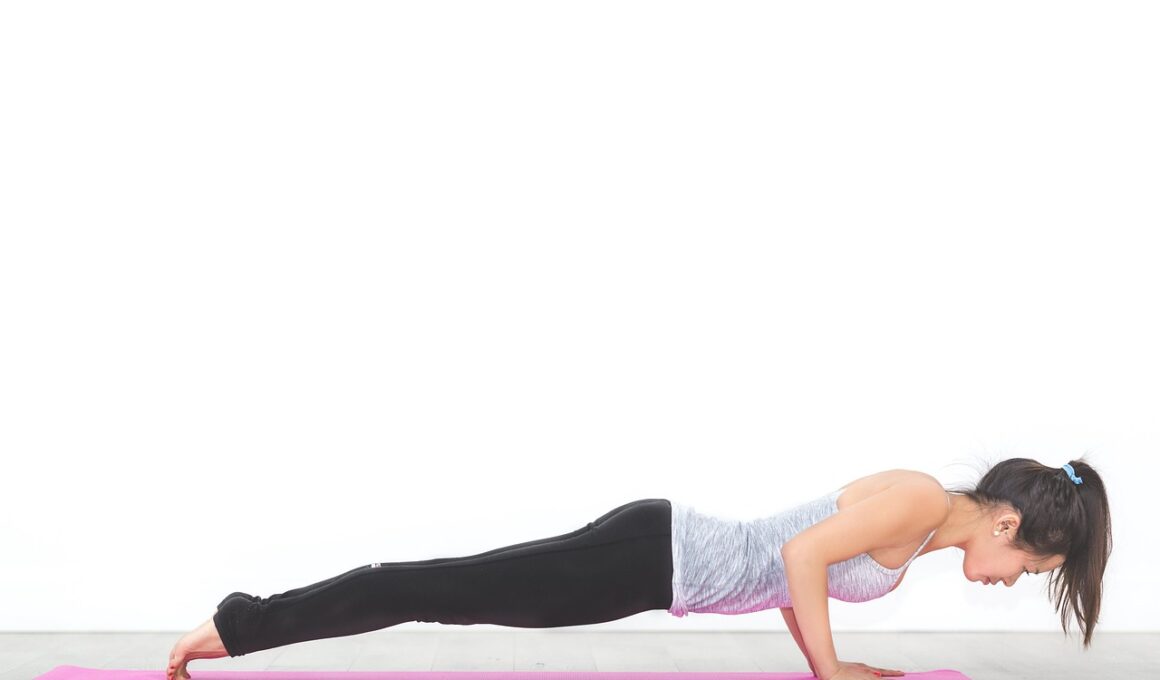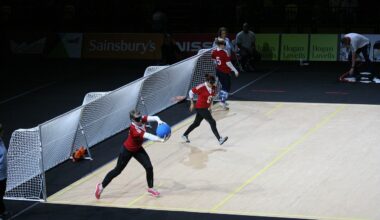Common Flexibility Mistakes and How to Fix Them at Home
Many individuals overlook essential aspects of flexibility training when working out at home. A common mistake is not warming up properly before stretching. Warm muscles are more pliable and less prone to injury. Instead of jumping straight into your flexibility routine, take a few minutes to increase your heart rate with light aerobic activities. This could include jumping jacks or a brisk walk in place. Following this, incorporate dynamic stretches such as leg swings or arm circles. These movements prepare your muscles and joints for deeper stretches. Additionally, using static stretches without preceding warm-up techniques can lead to muscle strain. It’s vital to prioritize this foundational step for effective results in flexibility training and overall fitness. Likewise, consider gradually increasing your stretching intensity. Many people aim for deep stretches right away, which is counterproductive. Listen to your body and proceed gently, allowing time for adaptation and improvement. Flexibility is a gradual process; hence consistent and mindful practice over weeks can yield remarkable improvements in your range of motion and performance. Utilizing this understanding can help optimize your home workouts and prevent injury.
Another frequent flexibility mistake involves improper technique during stretching exercises. Many individuals either bounce while stretching, which can cause harm, or hold their stretches deficiently without engaging the targeted muscles correctly. To maximize stretch effectiveness, ensure you are holding each position steadily, typically for 20 to 30 seconds. Focus on breathing deeply, which helps relax your muscles and encourages a better stretch. Furthermore, make sure to target various muscle groups for a comprehensive approach. Many home workouts neglect certain areas like the hips, back, and shoulders. Integrate stretches like the butterfly stretch, spinal twists, and shoulder stretches into your routine. These exercises promote overall flexibility and reduce the risk of injuries in more intensive workouts later. Additionally, remember not to stretch cold muscles. Stretching too soon after waking up may not yield the best results. Opt for a routine that allows for a gradual increase in flexibility instead. Finally, consider using props if needed, such as yoga blocks or straps, to support your stretches. This assistance can help you achieve correct forms without straining. Be consistent in these practices, and your flexibility will improve over time.
Neglecting Consistent Practice
Consistency is fundamental to achieving flexibility improvements; however, many individuals fail to practice regularly, thus stunting their progress. Skipping days or not having a structured routine can lead to muscle tightness and diminish the previous advancements made. Create a flexible workout schedule that includes designated stretching sessions, ideally multiple times each week. Even short, daily sessions can contribute significantly to long-term flexibility gains. You don’t need lengthy workouts; even 10-15 minutes of focused stretching can be beneficial. Incorporate both dynamic and static stretches to provide a well-rounded approach. Repetition of exercises ensures your muscles adapt and become accustomed to increased flexibility demands, while varied stretches target different muscle groups effectively. Moreover, consider joining online flexibility classes that can help keep you engaged and motivated. Finding a community that shares similar goals will also provide support and encouragement on your journey. Also, tracking your progress can boost motivation. Take note of your increased range of movement and any reduced muscle tension. Having physical records demonstrating your improvement can ignite a desire to maintain this beneficial practice for enhancing your home workouts.
Another common flexibility mistake is not understanding personal limits and pushing too hard. While it’s crucial to challenge oneself, sustaining a balance between stretching and not overstretching is imperative for safety. Stretching should feel uncomfortable at times; however, sharp pain is a red flag. Instead of straining during stretches, aim for mild discomfort, indicating your muscles are being adequately challenged without risking injury. Therefore, learn to distinguish between feelings to progress safely. Additionally, some individuals may pursue overly ambitious goals too quickly without patience. Remember that flexibility improves gradually; focus on attainable milestones instead of immediate, dramatic changes. Consider documenting your flexibility achievements, similar to journaling, to track progress. This reflective practice helps spotlight growth over time while motivating continued efforts. Incorporate variation into your routine to ensure all muscle groups receive attention, as neglecting certain areas can hinder overall progress. Flexibility training isn’t simply about reaching a certain split or touch your toes; it equates to enhanced mobility and muscle function. So, in your home flex workouts, remain patient and aim for rainbows instead of simply seeking instant results.
Ignoring Breath Control
Breath control is frequently overlooked, yet it plays a crucial role in enhancing flexibility exercises. Failing to connect breathing techniques with stretching can lead to increased tension and resistance in your muscles and body, negating the benefits of the stretch. Instead, encourage deep and rhythmic breathing. Inhale deeply through your nose while entering the stretch and exhale steadily through your mouth as you release. This method signals to your body that it’s safe to relax, allowing muscles to loosen. Try counting breaths during stretches as a form of rhythm, which can help you engage with each movement more effectively. Deep breathing also enhances oxygen intake within your muscles, supporting their performance during stretches and reducing fatigue. Additionally, many find utilizing breath control boosts their mental focus during workout sessions. Consider meditative practices alongside flexibility training to amplify both mental and physical benefits altogether. Building a routine that integrates mindfulness can also lead to impressive cumulative results in flexibility. Allow yourself the grace to immerse fully in each movement rather than simply going through the motions. Therefore, incorporate breathing techniques into your home workout paradigm for improved flexibility.
An overlooked flexibility mistake is the reliance solely on specific exercises without cross-training. Just performing passive stretches may limit overall muscle engagement and can lead to imbalances in muscle flexibility. Incorporate a mix of flexibility-enhancing activities like yoga, Pilates, or dance, which provide dynamic movements, thus enriching strength and balance alongside flexibility. These practices also incorporate controlled movements and foster mindfulness, elements vital for sustained improvement. Additionally, engaging in dynamic movements during warm-ups prepares your body for deeper stretching and supports functional flexibility. Furthermore, cross-training introduces variety, making workouts more enjoyable and preventing monotony. Dynamic stretching, where you actively move in and out of a stretch, can elevate your flexibility training. Examples of this include leg swings and torso twists, which incorporate full-range muscle engagement, making them efficient. Not only does cross-training elevation improve flexibility performance, but it also reduces injury risks associated with repetitive motions. It becomes increasingly valuable while working out at home, where variety can sometimes be limited. Therefore, consider diversifying your approach to flexibility alongside your strength training regimen to create more holistic development.
Set Realistic Goals
A final crucial point regarding flexibility training mistakes is the importance of setting realistic goals. Many individuals become discouraged by what seems to be slow progress in their flexibility journey. Without clear objectives or an understanding of personal limits, demotivation can quickly set in. Establish short and long-term goals related to your flexibility targets. For example, if your goal is to perform a full split, aim first to achieve improved hip flexor mobility. Break it down into manageable milestones enhances focus and provides clear pathways toward desirable outcomes. Recognize that flexibility is not something achieved overnight; it takes time and diligence for significant changes to manifest. Maintain a journal or an app to note your progress throughout the process. Celebrating small achievements bolsters motivation and engagement in your training. Remember that everyone’s body adapts differently, meaning flexibility improvements may come quicker for some than others. Aim for patience; your commitment towards achieving ease in your flexibility journey will bear fruits eventually. Embrace the process of your flexibility workout within the comfort of your home for progressive outcomes.
Finally, always assess your body and modify your routine according to its needs and responses. Understanding your unique mechanics can prevent common pitfalls associated with flexibility training mistakes. Embracing this adaptable approach directly correlates with achieving sustainable progress in enhancing your flexibility while working out at home. Evaluate your body’s feedback regularly. For example, if specific areas remain tight after several sessions focusing on them, re-evaluate the stretching techniques being used. Perhaps warmth, pressure, or the type of stretches being completed requires adjustment. Additionally, consider engaging with online platforms that offer guidance on flexibility training and techniques tailored to various fitness levels, leading to better results. Your body may provide essential clues signaling when to adjust your method for maximum efficiency. Incorporating rest days optimally into your routine enhances recovery and flexibility, reinforcing that stretching should never be excessively rigorous and should feel restorative. Combining smart practices with flexibility training can make for a rewarding experience while working out at home. Focus on holistic growth, and over time you will recognize profound improvements in your overall flexibility and well-being.


